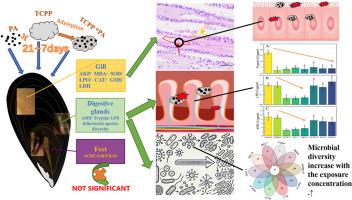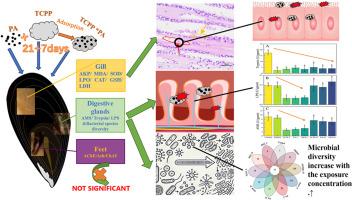超越载体效应:聚酰胺微塑料和TCPP共同驱动贻贝在环境浓度下的生理毒性
IF 7.3
2区 环境科学与生态学
Q1 ENVIRONMENTAL SCIENCES
引用次数: 0
摘要
海洋微塑料污染是一个受到广泛关注的全球性问题,海洋微塑料的风险评估成为人们关注的重要话题。然而,过去广泛使用的不科学的评估方法凸显了重新校准海洋微塑料生态风险判断的必要性。在这项研究中,我们对滤食性贝类厚壳贻贝(Mytilus coruscus)进行了暴露实验,使用环境浓度的海洋微塑料PA碎片与常见的有机磷阻燃剂三(1-氯-2-丙基)磷酸盐(TCPP)复合。实验结果表明,在环境浓度下,TCPP和PA的联合胁迫对厚壳贻贝的生理毒性表现为吸附效应而非载体效应,目前环境浓度与2050年预测环境浓度之间的毒性效应无显著差异。然而,与对鳃组织的影响相比,微塑料和TCPP似乎对贻贝的消化腺产生了不可逆的影响。贻贝内环境细菌种群多样性受到影响,提示潜在的生态后果。本文章由计算机程序翻译,如有差异,请以英文原文为准。


Beyond carrier effects: Polyamide microplastics and TCPP jointly drive physiological toxicity in mussels at environmental concentrations
Marine microplastic pollution is a global problem that has received widespread attention, making the risk assessment of marine microplastics a crucial topic of concern. However, unscientific assessment methods have been widely used in the past, highlighting the necessity to recalibrate the judgment of the ecological risks posed by marine microplastics. In this study, we conducted exposure experiments on the filter-feeding shellfish, thick-shelled mussels (Mytilus coruscus), using ambient concentrations of marine microplastic PA debris compounded with the common organophosphorus flame retardants pollutant, Tris (1-chloro-2-propyl) phosphate (TCPP). The results of our experiments showed that the combined stress of TCPP and PA exhibited an adsorption effect on the physiological toxicity on thick-shell mussel at environmental concentrations rather than a carrier effect, and there was no significant difference in the toxic effects between the current environmental concentration and a predicted environmental concentration in 2050. However, microplastics and TCPP appeared to exert irreversible effects on the digestive glands of mussels, compared to their effects on the gill tissues. The diversity of bacterial populations in the mussels' internal environment was affected, indicating potential ecological consequences.
求助全文
通过发布文献求助,成功后即可免费获取论文全文。
去求助
来源期刊

Environmental Pollution
环境科学-环境科学
CiteScore
16.00
自引率
6.70%
发文量
2082
审稿时长
2.9 months
期刊介绍:
Environmental Pollution is an international peer-reviewed journal that publishes high-quality research papers and review articles covering all aspects of environmental pollution and its impacts on ecosystems and human health.
Subject areas include, but are not limited to:
• Sources and occurrences of pollutants that are clearly defined and measured in environmental compartments, food and food-related items, and human bodies;
• Interlinks between contaminant exposure and biological, ecological, and human health effects, including those of climate change;
• Contaminants of emerging concerns (including but not limited to antibiotic resistant microorganisms or genes, microplastics/nanoplastics, electronic wastes, light, and noise) and/or their biological, ecological, or human health effects;
• Laboratory and field studies on the remediation/mitigation of environmental pollution via new techniques and with clear links to biological, ecological, or human health effects;
• Modeling of pollution processes, patterns, or trends that is of clear environmental and/or human health interest;
• New techniques that measure and examine environmental occurrences, transport, behavior, and effects of pollutants within the environment or the laboratory, provided that they can be clearly used to address problems within regional or global environmental compartments.
 求助内容:
求助内容: 应助结果提醒方式:
应助结果提醒方式:


